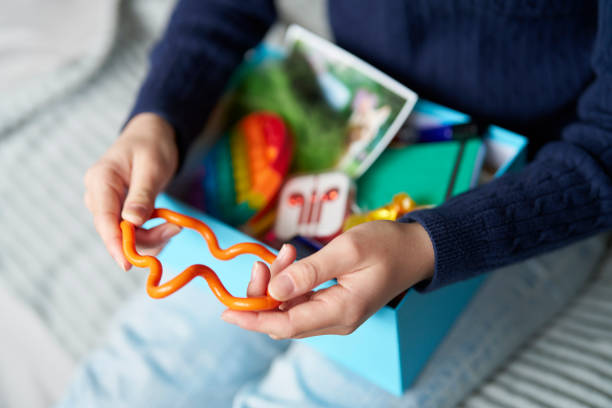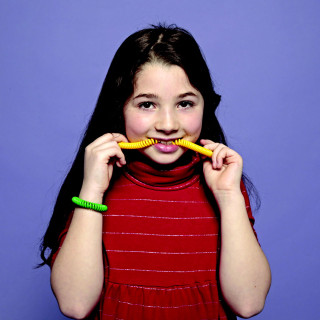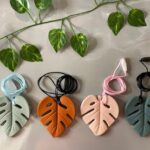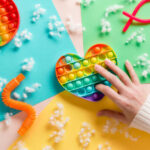Chew necklaces are no longer niche sensory tools, but rather transformative tools that help people navigate complex sensory processing challenges, providing discreet, stylish, and practical solutions for self-regulation. Unlike traditional fidget toys, chew necklaces are both functional and aesthetically pleasing, meeting the sensory needs of people with autism, ADHD, and anxiety.
Next, we’ll explore the many benefits of chew necklaces for people with autism, anxiety, and ADHD, diving into their unique design, scientific evidence, and real-world impact. We’ll combine innovative perspectives with practical insights to reveal why these sensory aids are more than just accessories, they’re game-changing experiences.
🧠The Neurosensory Science Behind the Chew Necklace: Why It Works
For individuals with autism spectrum disorder (ASD) and ADHD, oral motor seeking is more than a quirk—it’s a regulatory mechanism. This drive to chew, suck, or bite is often the body’s attempt to self-soothe, increase focus, or mitigate stress in overstimulating environments.
Clinical studies, such as one published in The American Journal of Occupational Therapy, support the use of oral sensory tools like ASD chew necklaces autism solutions to meet these specific needs.
Oral Motor Seeking: A Crucial Piece of the Puzzle
- A Calming Mechanism: The chewing action engages the jaw muscles, providing deep pressure input that soothes sensory seekers. For people with autism, chewing necklaces can change bad habits such as chewing clothes or nails, protecting physical health and social confidence.
- Sensory Needs: While many sensory tools are geared toward children, chew necklaces for anxiety and ADHD are increasingly designed for adults. As Autism Innovators points out, adults with autism often lack age-appropriate sensory tools.
- Tailored Toughness:The chew necklaces come in different hardness levels to accommodate varying chewing intensities. Ensuring durability even for children with strong chewing habits while protecting sensitive teeth. This custom design makes the chew necklace for ADHD and autism a versatile tool for a variety of sensory conditions.
Key Insight: Chewing activates proprioceptive input in the jaw, which is deeply calming and helps re-center emotional and cognitive balance—making the chew necklace autism link neurologically sound.
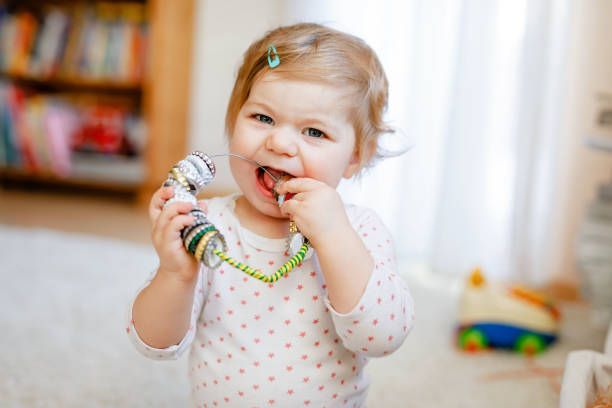
🧩Why a Chew Necklace Isn’t Just a Toy—It’s a Daily Coping Strategy
Subtle and Stylish for Everyday Use
Gone are the days when sensory tools had to look clinical. Modern chew necklaces for anxiety and necklace for stress and anxiety are designed to blend seamlessly with everyday outfits. This aesthetic advancement is crucial for teens and adults who don’t want to feel stigmatized for using sensory aids in public.
Some even function as shift necklaces for anxiety or whistle necklaces for anxiety, allowing users to combine deep breathing techniques with oral motor regulation.
🔗 Read: Why Functional Fashion Matters in Mental Health Support
Multi-Sensory Stimulation in One Tool
A well-designed chew necklace for ADHD user doesn’t only provide oral input—it may also include:
- Tactile textures (bumpy, ridged, smooth)
- Temperature play (some materials are cool to the touch)
- Sound (e.g., air whistles for mindful breathing)
This holistic design supports kids and adults with ASD, sensory processing disorder (SPD), and anxiety, helping them manage transitions, public outings, and emotionally charged moments.
Redefining Stimming: Chew Necklaces as Empowering Tools
Stimming, or self-stimulatory behavior, is a cornerstone of sensory regulation for neurodivergent individuals. Chew necklaces for autism elevate stimming from a potentially destructive habit to a socially acceptable, health-conscious practice. By offering a safe outlet, these necklaces empower users to embrace their sensory needs without fear of judgment.
Discreet Design: Blending Style with Function
Unlike bulky fidget toys, ASD chew necklaces prioritize discretion. Necklactic offers pendants shaped like gemstones or flowers, which double as fashionable accessories. This aesthetic integration allows users to manage sensory needs in professional or social environments without drawing attention, making them ideal as a necklace for stress and anxiety.
Safety First: Materials and Features
Safety is paramount in chew necklace design. Brands like Gummy Chic use food-grade silicone, free of BPA, phthalates, and lead, with breakaway clasps to prevent choking hazards. These features ensure that chew necklaces for anxiety and ADHD are safe for users of all ages, particularly for those with intense chewing needs.
Community-Driven Innovation
Many chew necklace creators are autistic-owned businesses, such as The All Things Sensory Shop, which designs products based on lived experience. This authenticity ensures that ASD chew necklace autism options resonate with the neurodivergent community, offering tools that reflect their unique needs and preferences.
Addressing Diverse Needs: Chew Necklaces for Anxiety, ADHD, and Beyond
The versatility of chew necklaces extends beyond autism, serving as an anti-anxiety breathing necklace or a whistle necklace for anxiety for those seeking alternative sensory regulation methods. Their adaptability makes them a go-to solution for a wide range of sensory challenges.
Anxiety Relief: A Subtle Ally
For individuals with anxiety, chewing provides a grounding mechanism. A shift necklace for anxiety can redirect nervous energy, reducing habits like nail-biting or hair-chewing. User reviews on Etsy highlight how these necklaces alleviate stress while blending seamlessly into daily wear, offering both comfort and style.
ADHD Focus: Channeling Restlessness
For those with ADHD, chew necklaces offer a tactile outlet to manage fidgeting, improving concentration in settings like school or work. Special Supplies notes that their sensory necklaces help children stay focused by providing a safe alternative to chewing non-edible objects, enhancing classroom engagement.
Sensory Processing Disorders: A Universal Tool
Beyond autism and ADHD, chew necklaces support individuals with sensory processing disorders (SPD). The Gafly Sensory Chewing Necklace, with its textured bumps, provides varied sensory input, making it a versatile tool for anyone needing oral stimulation to regulate sensory experiences.

🌍Social Implications: Reframing Sensory Tools as Empowering Accessories
Instead of hiding sensory needs, chew necklaces can act as a form of advocacy and empowerment. Communities are increasingly sharing unfiltered stories online, which help reduce stigma and encourage awareness around neurodiversity.
For instance, educators using chew necklaces in inclusive classrooms report fewer behavioral disruptions, greater focus, and improved emotional regulation among ASD and ADHD students.
🛒Personalized Chew Necklaces: Things You Didn’t Consider
Choosing the perfect chew necklace requires considering individual sensory preferences, chewing intensity, and aesthetic needs. When shopping, parents and adults often focus only on material or design, and overlooked factors can make or break your shopping experience. Here’s how to make a smart choice:
| Consideration | Details | Examples/Recommendations |
|---|---|---|
| Assessing Chewing Intensity | Match the necklace’s toughness to the user’s chewing intensity to ensure durability and satisfaction. | The Autistic Innovator’s Heart Chew Necklace for hard chewers; Shark Tooth Necklace for light chewers. |
| Style and Discretion | Designs should balance sensory function with personal style to suit professional or social settings. | Munchables offers subtle beaded necklaces and vibrant pendants for personal expression. |
| Practical Considerations | Regular inspection for wear and tear ensures longevity and user safety. | Gafly products with adjustable cords and breakaway clasps; Special Supplies recommends routine checks. |
But here are two overlooked factors that are also important:
- Purpose Alignment: A shift necklace for anxiety is better for those who struggle with panic attacks, while an ASD chew necklace autism product should prioritize textural variety.
- Cleaning Routine: Not all necklaces are dishwasher-safe. Regular sanitizing is crucial to prevent bacterial buildup—especially for immune-sensitive kids.
💡 Addressing Real Concerns for Family and Adult Anxiety
To ground ourselves in realistic values, let’s look at the most searched and discussed questions on online forums:
“Is a chew necklace safe for toddlers and nonverbal autistic kids?”
Yes—with supervision and FDA-grade materials. Look for BPA-free silicone chew necklaces specifically labeled for ASD chew necklace sensory support. Brands offering breakaway clasps and adjustable cords are highly recommended for safety.
“Do chew necklaces really help with anxiety?”
Absolutely. In fact, many people compare them to tools like anti-anxiety breathing necklaces. They help redirect nervous habits like nail biting or hair pulling, providing a mindful, sensory outlet in moments of panic or overstimulation.
“Will people judge my child for wearing one?”
This is where design innovation matters. Brands are increasingly offering chew necklaces that resemble dog tags, pendants, and even tribal or gemstone accessories—reducing visibility as a “special needs aid” and increasing self-confidence.
🧭Embrace Sensory Empowerment – Chew Necklaces Promote Self-Regulation, Focus and Self-Identity
For people with autism, anxiety, and ADHD, the best chew necklaces are more than just products; they are lifestyle tools designed to help people self-regulate, focus, and maintain dignity. Whether you’re a parent looking for an alternative to chewing or an adult seeking subtle sensory support to relieve anxiety, the right chew necklace can make a difference.
The right chew necklace provides a safe, stylish, and practical solution that can bring a new sense of comfort and confidence. Ultimately, by normalizing and accepting sensory tools like chew necklaces, we pave the way for a more empathetic, understanding, and self-aware society.
The Future of Chew Necklaces: Innovations
As awareness of sensory needs grows, so does innovation in chew necklace design. Emerging trends include eco-friendly materials, customizable textures, and integration with other sensory tools, such as whistle necklaces for anxiety that combine chewing with breathing exercises.
Eco-Friendly and Sustainable Designs
Sustainability is gaining traction, with brands exploring biodegradable silicone options to reduce environmental impact. These advancements align with the neurodivergent community’s values of inclusivity and accessibility.
Multifunctional Sensory Tools
Future chew necklaces may incorporate additional features, like haptic feedback or calming scents, to enhance their sensory benefits. Such innovations could redefine necklaces for stress and anxiety as holistic wellness tools.
